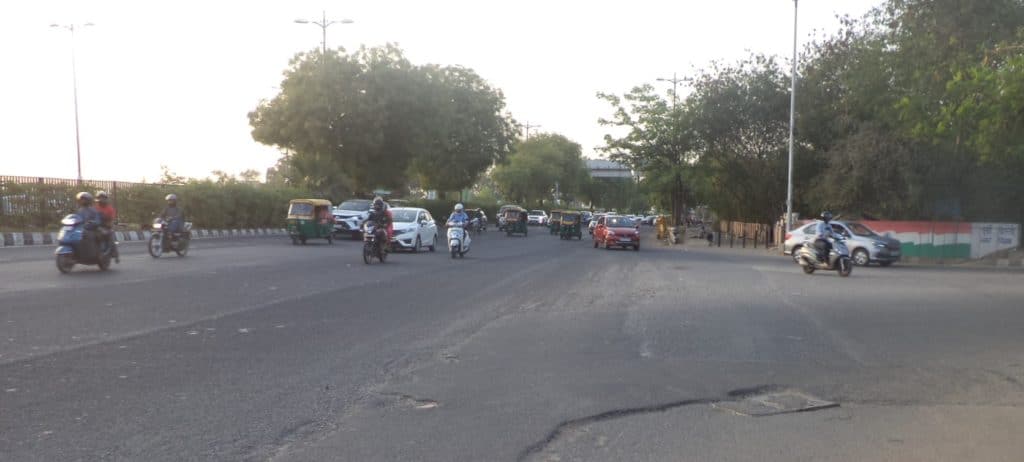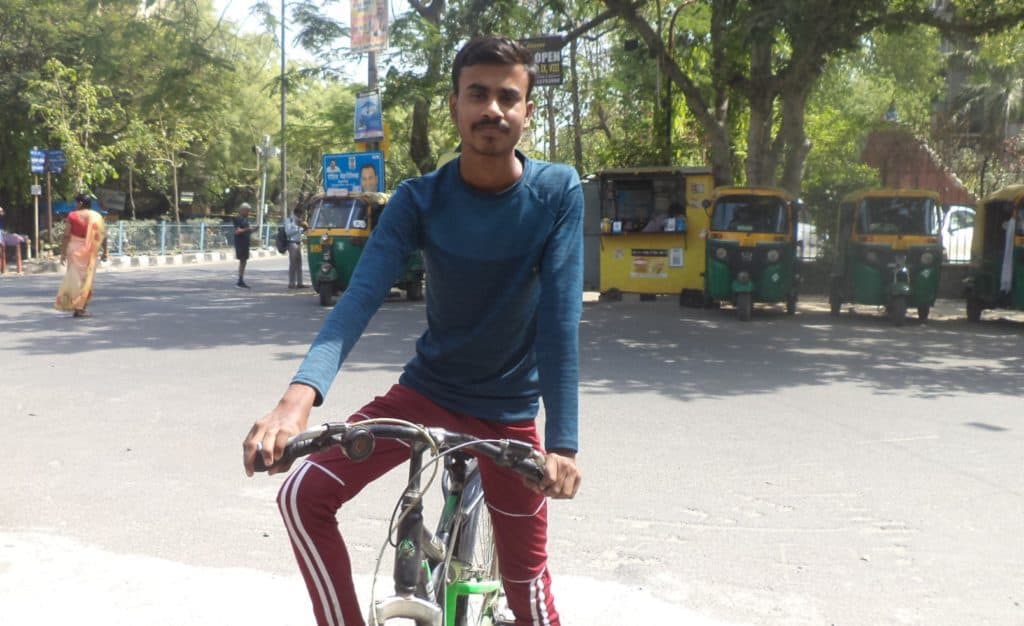The Delhi administration is finally realising the usefulness of the humble cycle. Not only as a much needed commute alternative, but also as a tool to combat Delhi’s perennial poor air quality.
Recently, vendors, factory workers, daily wage labourers and other workers who cycle daily to work joined forces to urge the Delhi government to fast track moves to create safe cycling infrastructure and dedicated cycle lanes.
The Delhi government reacted by saying it will develop dedicated cycle tracks across the national capital, especially on stretches that are most used by cyclists.
Read more: Delhi divided: Will new parking management plan reduce traffic congestion?
“The roads are very bad and there are no separate cycle tracks but we need to cycle to earn our livelihood,” said Satnam Singh, who has been selling incense sticks and other pooja items from his cycle for the last 20 years.
With about 10 million vehicles jostling for space on the roads, on an average two cyclists lose their lives every week, according to a study by the Centre for Science and Environment (CSE).
Many cyclists prefer to travel in groups to fight what they call the “tyranny of motorists”, and demand their share of road space. It is not unusual to see such groups commuting to work so they can help each other if they run into trouble.
Karan, 17, a 12th class student in a government school in East Delhi, uses his cycle to deliver a local newspaper brought out in East Delhi called “Mayur Infomail,” before cycling to school. “The cycle is the cheapest mode for me though it is risky as traffic is heavy,” says Karan.
No support for cyclists
A study released by The Energy and Resources Institute (TERI) in January 2019 estimated that if bicycles were to substitute the two- and four-wheelers used for short-distance trips, “it can result in an annual benefit of Rs 1.8 trillion”.
The reality is that nothing has been done in Delhi to support cycling. “There is a cycling lane in South Delhi but it is more in the nature of a beautification project and whatever cycling lanes are there have been barricaded by the police,” said Avikal Somvanshi, architect and Programme Manager, Sustainable Development, Centre for Science and Environment.
“There is a sizeable population of cyclists, mostly blue collared workers, but they have no rights on the road nor any dignity,” adds Avikal. “And the way cycle tracks are being developed with focus on south Delhi, it seems the government wants to cater to the rich ignoring the poor for whom the cycle is the main mode of transport”.
“Although approximately 35% of Delhi’s population of Delhi owns cycles, only around 4.5% use them for commuting due to lack of safe cycling facilities or cycle-parking facilities,” said Karuna Raina, Director, Public Policy, of SAVELIFE Foundation (SLF), an independent, non-profit, non-governmental organization committed to improving road safety with on-ground interventions and advocacy for stronger national level policies to create a sustainable impact.
“The lack of specific infrastructure features to ensure a safe journey like cycle lanes, leaves cyclists vulnerable to impact and injury. Fatalities among cyclists has increased from 36 in 2019 to 48 in 2020,” adds Karuna.
Preventing fatalities
Karuna said the Delhi Government has taken steps to augment safety of cyclists and prevent road fatalities and injuries involving cyclists. “The Delhi government is currently working on redesign of 540 km of city roads, and about 30 kms of bicycle tracks to be made on it,” said Karuna.
The Delhi Development Authority (DDA) is constructing a 16-km dedicated cycling corridor and an 800m stretch on Ring Road will include a bicycle track.
The government has also undertaken a project in partnership with SaveLIFE Foundation to transform four high-fatality intersections — Bhalswa Chowk, Burari Chowk, Gandhivihar bus station intersection, and Rajghat intersection into pedestrian and cyclist friendly zones. Titled “Tactical Urbanism”, this involves a temporary redesign to reallocate road space for the safety of pedestrians, cyclists, and non-motorised transport and reduce their exposure to motorised traffic.
Read more: Green commuters: “I see no reason why I should not cycle to work ” – Karthik
“However, the creation of new cycle paths needs to be clubbed with strict enforcement,” cautions Karuna. “Further, there should be clear signage to indicate the beginning and the end of a cycle path. Finally, awareness campaigns through the radio/advertisements should be conducted to make road users aware of proper usage of the dedicated cycle paths”.
It is not that Delhi does not have cycle tracks at present. The city roads at several corridors have dedicated tracks. “But these are encroached by street vendors or in poor condition,” said a senior Delhi government official.
Anil Kumar who works as a driver has been commuting to his place of work by cycle for the last 15 years. A resident of East Delhi colony Trilokpuri, Kumar, being a car driver, feels doubly concerned about the traffic on the roads where the cyclist is always in danger of being hit by a fast moving vehicle. “There is a need for a separate track for cyclists but until that is made, we are always in danger of being hit anytime”.
“It is a matter of concern that Delhi has still not been able to wake up to the mobility crisis faced by pedestrian and cyclists in Delhi,” says Rajendra Ravi, Member of Sustainable Urban Mobility Network India (SUMNET), World Car-free Network and National Cyclist Union, Delhi. “For urban citizens, cycling provides access to livelihood and becomes a means to livelihood. Protecting means of livelihoods of 80% low-income working class who cycle nearly 10 kilometres to earn their livelihood should definitely be a government concern.”
Committed to bring back sustainable mobility options to cities, like walking and cycling, Sarika Panda Bhatt, co-founder of Raahgiri Day said, “Riding a cycle in Delhi is not only difficult but extremely unsafe, especially in the absence of laws protecting vulnerable road users”.

Design for non-motorised commuters
According to a trend report, many people take up cycling as a hobby, but quickly discontinue as they feel demotivated after jostling for a secure space on the roads with buses, trucks and other vehicles. “We demand that the state ensures that non-motorised transport road users are prioritised in street design rather than motorised road users,” says Sarika.
A 16 page “Survey of Livelihood Cyclists in Delhi – opportunities and challenges,” conducted by CEED (Centre for Environment and Energy Development) along with Purpose and ASAR called “Cycle Chalega, Dilli Badhegi,” found that 97% of respondents out of nearly 1400 people are willing to use cycles as a mode of daily transport.
The survey indicated that lack of safe and convenient cycling infrastructure, absence of dedicated cycling lanes, poor air quality and unruly traffic are deterrents to more Delhi citizens taking up cycling.
According to the survey, livelihood cyclists in Delhi feel cycles are the fastest and easiest way to move across the city.
Some survey numbers
The survey asked people in jobs like postmen, courier service and delivery boys, how many kilometres they had to commute by cycle on a daily basis. About 15% respondents had to travel for more than 10km, 11% travelled 10 to 15km, while 4% did more than 15km. The maximum, 35%, stated covering a distance of 5-10 kms by cycle on a daily basis. A distance of 0-5 km was covered by the remaining respondents (50%).
More than half the respondents said they feel unsafe while cycling in heavy traffic. Nearly 47% said they feel upset at the unruly behaviour of other drivers. Around 37% stated that the probability of theft of cycles was a constant worry while another 32% stated that cycling during bad weather conditions was a huge challenge. Lack of proper cycling infrastructure was cited as a challenge by 16% respondents.
Maximum respondents who stated feeling unsafe in traffic (58%) and bad behaviour of other drivers (54%) were unskilled workers. Likewise, it was seen that the owners of petty shops and small businesses were the ones most concerned about cycle thefts (46%).
Painting a grim picture of the traffic situation in the capital, Vimlendu Jha, Executive Director, Swechha and a leading Indian environmentalist said: “About 91% of Delhi livelihood cyclists use cycles every day to commute, but our roads are not designed for safe walking and cycling. For almost 11 lakh cyclists in Delhi, there is just 100 km of cycle tracks.

“Also, Delhi has been dealing with the air pollution crisis for years now. Delhi’s air pollution problem can’t be solved by traditional means — bicycle infrastructure, last-mile connectivity is a must. Therefore, there is a dire need to strengthen policies to protect pedestrians and their right to walk and cycle in Delhi.”
Cycling is increasingly being seen as a sustainable transport alternative and is included in several projects, promising Delhi’s inhabitants green commute choices while considering the requirements and safety of cyclists.
According to the 2011 census, about 30.6% of Delhi households own a bicycle, and about 11% of the working population cycles to work.
Reiterating that ‘streets belong to all’, Sarika Panda Bhatt, co-founder of Raahgiri Day said, “Delhi has yet to wake up to the mobility crisis and the city needs implementation of pedestrian and cycling plans. I feel that it is our responsibility to stand up for a cause that demands robust laws to protect walkers and cyclists. I myself don’t use a car and move around the city on my cycle. I really hope that soon we will have a legitimate and well-designed space that is walkable and cyclable in and around Delhi.”
The Dilli Dhadakne Do campaign
The #DilliDhadakneDo campaign is a collective effort of civil society organizations working on clean air solutions for Delhi including the need for better and sustainable public transport, in particular, cycling. The initiative has started a movement to help make the capital a cycling-friendly city.
The campaign aims to urge the Delhi government to enact a ‘Non-motorised Vehicle Act’ and include laws that safeguard the interests of pedestrians and cyclists.
It wanted creation of a more connected network for cyclists, ensuring a 5 km safety radius with bicycle lanes across all Delhi schools to protect children, mandating markets and associations to have a dedicated free cycle parking infrastructure and ensuring government offices having dedicated cycle parking infrastructure.
Also read:
- Cycling will transform Hyderabad and create a happier city: Santhana Selvan, Bicycle Mayor
- Getting cyclists back on the roads of Pune needs more than just directives
- Green commuters: “I see no reason why I should not cycle to work ” – Karthik
- Behavioural change among citizens can be a game-changer: Bicycle Mayor Felix John